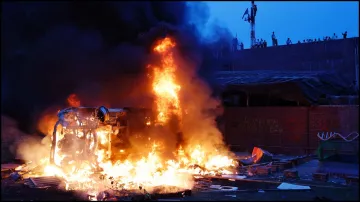Bangladesh protests turn anti-Hindu, ISKCON temple set ablaze along with idols of deities
Weeks of violent protests in Bangladesh brought a tumultuous end to Sheikh Hasina's 15-year-old reign as she was forced to resign and flee the country on Monday. Hasina had brought stability to the country in 2008 after a rise of Islamist extremism had threatened the Hindu community in Bangladesh.

Bangladesh crisis: As unrest escalates in Bangladesh, it has come to light that an ISKCON temple in Meherpur, located in the Khulna Division of the country, has been set ablaze along with the idols of deities including Lord Jagannath, Baladev and Subhadra Devi. Some devotees living in the temple managed to escape the chaos and survive as violent protests gripped the country on Monday, culminating in Prime Minister Sheikh Hasina's resignation.
"As per the info I have received, one of our ISKCON centre (rented) in Meherpur (Khulna division) was burnt including with the deities of Lord Jagannath, Baladev and Subhadra Devi. 3 devotees who lived in the center some how managed to escape & survived," said Yudhistir Govinda Das, the Country Director of Communications and National Spokesperson for ISKCON India on X.
The attack on the ISKCON centre is part of a broader pattern of violence and unrest that has engulfed Bangladesh in the past few weeks. Sheikh Hasina's resignation and chaotic departure from Bangladesh following weeks of violent protests that left 300 dead has set off speculation that opposition Bangladesh National Party (BNP), led by former PM Khaleda Zia, would take the helm of power. This raised fears of attacks on the Hindu community there as well as deteriorating relations with neighbouring India.
According to reports, dozens of Hindu houses and temples, including a Kali temple were vandalised by violent protesters and two Hindu councillors have reportedly been shot dead. An unruly mob on Monday damaged the Indira Gandhi Cultural Centre (IGCC) and the Bangabandhu Memorial Museum located at the Dhanmondi area in the Bangladesh capital, eyewitnesses said.
Hasina had long been credited for bringing political stability after Khaleda Zia-led Bangladesh National Party (BNP), which had been blamed for rising Islamist violence in the country.
How many Indians are in Bangladesh?
The Indian government convened an all-party meeting about the Bangladesh issue at the Parliament House at 10 am, where External Affairs Minister S Jaishankar briefed various party leaders on the developments in the neighbouring country. The government informed that the situation in Bangladesh is not so dire that there is a need to evacuate Indians who are 13,000 in number. At least 8,000 Indians have returned.
The all-party meeting was attended by Home Minister Amit Shah, Defence Minister Rajnath Singh, Parliamentary Affairs Minister Kiren Rijiju and LoP Rahul Gandhi among others. After the meeting, Jaishankar appreciated the support from all MPs. Rahul Gandhi also questioned the government on the possible involvement of a foreign hand in the Bangladesh crisis. The central government said that all possible angles were being looked into.
India 'concerned about situation of minorities' in Bangladesh
The Indian government has also expressed concerns about the situation of minorities in Bangladesh, said sources. This came amid fears that Islamist groups had taken advantage of the lack of leadership in the country to target the Hindu minority in the country, which has often faced discrimination and persecution in the country.
The situation was reminiscent of the 2021 anti-Hindu violence that took place after Prime Minister Narendra Modi's visit to Dhaka, when protests broke out across the country and numerous Hindu temples were attacked. With the BNP and the banned Jamaat-e-Islamic party set to take the reins of the government with the military, these fears have been exacerbated once more.
What happened in Bangladesh?
The massive protests in Bangladesh were initially against the controversial quota system in government jobs, but soon spiralled into a broader agitation against the Awami League government after Hasina's 'razakar' remarks and the harsh police crackdown on protesters. While the initial protests calmed down after the Supreme Court scaled back the quotas, the recent unrest broke out as several students demanded Hasina's resignation.
With police firings, mob beatings, and arson across the country, at least 135 people were killed in Bangladesh on Monday during unrest, according to Dhaka Tribune. The country announced on Monday that the clashes between demonstrators and members of the Awami League claimed the lives of at least 96 people in police firings. The protests culminated in Sheikh Hasina's abrupt resignation and departure from the country as several people stormed her official residence in Dhaka.
Bangladesh's Army Chief will meet student protest leaders on Tuesday as the country awaits the formation of a new government. Traffic was lighter than usual in the usually chaotic streets of Dhaka and schools reopened with thin attendance after closing down in mid-July as protests against quotas in government jobs spiralled. "I call upon the people of Bangladesh to display restraint and calm in the midst of this transitional moment on our democratic path," Tarique Rahman, the exiled acting chief of the opposition Bangladesh Nationalist Party (BNP), said in a post on X on Tuesday.
Army Chief General Waker-Uz-Zaman held talks with leaders of major political parties - excluding Hasina's long-ruling Awami League - to discuss the way ahead and said it was "unanimously decided" to immediately release BNP chairperson and Hasina's long-time nemesis, Khaleda Zia, who was convicted and jailed in a graft case in 2018. A BNP spokesperson said on Monday that Zia was in hospital and "will clear all charges legally and come out soon".
ALSO READ | Bangladesh Air Force aircraft takes off from Hindon airbase, Sheikh Hasina not on board: Sources